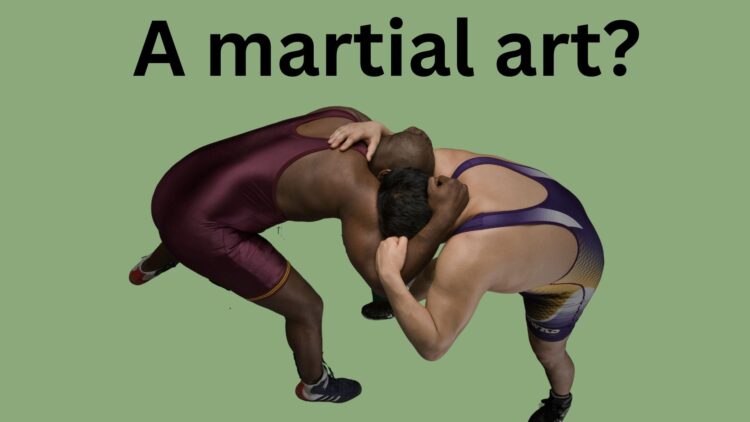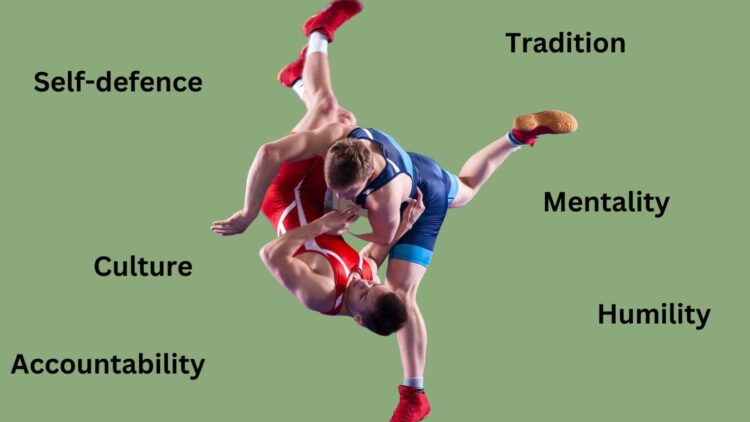
One of the world’s oldest and most noble sports, wrestling comes in many forms and is practiced in various ways around the globe. Regardless of the form, it requires not just strength and power but also technical ability and tactical knowledge to gain victories.
While the above is all agreed upon, one question that often hangs over the sport is whether wrestling is simply a sport or whether it should also be considered a martial art. Today, we’ll answer this burning question and explore whether wrestling is a martial art or not. Let’s dive straight in!
IS WRESTLING A MARTIAL ART?

The short answer: Wrestling is a martial art.
Those who believe in the artistry of wrestling will point to the many shared characteristics wrestling has with other martial arts. For example, being disciplined and accountable for your actions, knowing that your own decisions and dedication will determine your success.
They also point to how it teaches basic athletic skills, produces great flexibility and core strength, and can improve your mental well-being, all of which are common traits of martial arts.
While that is true, those who disagree will point out how all the traits mentioned above are true of various individual and team sports, though they would never be considered martial arts.
Moreover, perhaps the main reason they point to is that the purposes of martial arts and wrestling are quite different. While martial arts focus on self-defense and protection, wrestling is more about defeating and attacking your opponent.
That said, other martial arts also feature kicks, strikes, and other moves designed to attack the opponent. Plus, wrestling does teach defense. This, plus the focus on humility and respect, makes us believe that, yes, wrestling is indeed a martial art!
WHAT IS WRESTLING?
Wrestling is a sport in which two unarmed opponents grapple to try and pin each other to the ground, force them out of a designated area, or cause them to fall or lose balance.
What you are expected to do depends on which type of wrestling you are doing. As with many ancient sports, various versions cropped up in various parts of the world. Greco-Roman wrestling was born out of different European styles of wrestling, while freestyle wrestling took influence from British and American forms. Both of these styles are featured in the Summer Olympics.
Other popular styles include sumo wrestling from Japan and Lucha libre from Mexico.
WHAT ARE MARTIAL ARTS?
Martial arts are codified, traditional systems of combat, which are practiced for many reasons: primarily self-defense, physical, mental, and spiritual well-being, preservation of culture, and entertainment. While they are related to fighting, hence the word “martial”, they take an artistic form, hence the full term “martial arts”.
When we think of martial arts, we tend to think of the Far East. Other than wrestling, the martial arts currently in the Summer Olympic program are judo from Japan, taekwondo from Korea, and the newest addition, karate, also from Japan. However, Brazilian jujutsu is obviously from Brazil, while sambo began in Russia.
Judo, jiu-jitsu, and sambo are examples of grappling martial arts, as are aikido and sumo. The other main category is martial arts involving strikes, such as punches and kicks. Karate, taekwondo, kung fu and muay thai all use strikes.
REASONS WHY WRESTLING IS A MARTIAL ART

So, what are the reasons that show that wrestling is indeed a martial art?
SELF-DEFENSE
While it is necessary to land moves on your opponent and score points, wrestling also uses various defensive techniques to block and counteract an opponent’s advances, thus promoting one of the core values of martial arts.
CULTURE AND TRADITION
Think of the ancient Olympic Games, and you’ll think of Greco-Roman wrestling. Think Mexico, and you’ll think lucha libre. The idea that different forms of wrestling do not preserve the traditions and cultural heritage of where they are from seems rather nonsensical! In fact, when you think of Japan, chances are you may think of sumo wrestling and judo.
HUMILITY AND ACCOUNTABILITY
In wrestling, it is one against one. If you lose, you cannot blame the conditions, the officials, or someone else around you. Instead, you quickly learn to not only accept defeat with good grace but also to take personal responsibility for your preparation and performance – just like any other martial art.
MENTALITY
Martial arts seek to improve the mental well-being of their participants as much as physical. In wrestling, a huge amount of mental resilience is needed to get through a match, while emotional strength is required to work past failures and losses.
WHY IS WRESTLING SOMETIMES NOT CONSIDERED A MARTIAL ART?
On top of the reasons outlined earlier, such as having traits and benefits no different from a plethora of other non-martial arts sports, wrestling is often excluded from the list of martial arts because of philosophical differences.
By that, we mean it is suggested that while martial artists will never look to get into a fight and will only use their skills to defend themselves, wrestlers are deemed to be competitive, putting winning above all else, and for that, they may be considered simply sportsmen.
Organizations like the WWE also deter the purists because, as the “E” tells us, the primary focus is on entertainment. That is not true of all wrestling, of course, but undeniably, it is true of such modern “entertainment”-based wrestling formats.
WRESTLING AND THE MMA
Talking of modern formats, mixed martial arts, or MMA, has exploded in popularity over the last decade thanks to the Ultimate Fighting Championship (UFC).
Wrestling accounts for a wide range of the moves that MMA fighters use, so it is no surprise that many MMA fighters come from a wrestling background. In fact, it is widely accepted that wrestling is the most important discipline in MMA, with many wrestlers dominating the pound-for-pound rankings!
Wrestling provides the core foundation on which MMA fighters build. It develops strength and enables fighters to maintain good stances, flexibility, and positioning. Furthermore, grappling is a useful way of preventing opponents from striking.
BEST WRESTLERS TURNED MMA FIGHTERS

Here are a dozen of the best and most famous wrestlers who have made the move to MMA, or from MMA to wrestling, or have always dabbled in both!
- Dave Bautista: Wrestling career – 1999-2010, 2014, 2019; MMA career – 2012. Heavyweight.
- Brock Lesnar: Wrestling career – 2000-2007, 2012-present; MMA career – 2007-2011, 2016. UFC Heavyweight Champion.
- Ken Shamrock: Wrestling career – 1989-1993, 1997-2004, 2009, 2018-present; MMA career – 1993-1996, 2000-2010, 2015-2016. UFC Superfight Champion.
- Ronda Rousey: Wrestling career – 2014-present; MMA career – 2010-2016. First female UFC Champion.
- Bobby Lashley: Wrestling career – 2005-2014, 2018-present; MMA career – 2014-2020. Heavyweight.
- CM Punk: Wrestling career – 1999-2014, 2021-present; MMA career – 2014-2018. Welterweight.
- Giant Silva: Wrestling career – 1998-2010; MMA career – 2003-2006. Heavyweight.
- Nathan Jones: Wrestling career – 1997-2008; MMA career – 1997. Heavyweight.
- Alberto Del Rio: Wrestling career – 2000-2018; MMA career – 2001-2019. Heavyweight.
- Dan Severn: Wrestling career – 1994-2013; MMA career – 1994-2012. UFC Heavyweight Champion.
- Bart Gunn: Wrestling career – 1991-2007; MMA career – 2006. Heavyweight.
- Sean O’Haire: Wrestling career – 2000-2006; MMA career – 2004-2007. Heavyweight.
WRESTLING VS. BJJ
BJJ, Brazilian Jiu-Jitsu, has many similarities with wrestling. They are both grappling martial arts, with BJJ fighters attempting to force their opponents into submission, as done in many forms of wrestling.
But, while wrestling focuses on taking an opponent down, BJJ focuses on ground techniques, meaning joint locks or chokeholds are the main ways of gaining the upper hand. BJJ also has a greater emphasis on technique rather than the simple raw power often exerted in wrestling.
WRESTLING VS. KARATE
A layperson may confuse wrestling and BJJ at first, but they are unlikely to do the same with wrestling and karate.
Karate uses strikes, not grappling, with kicking being the chosen method in the popular Japanese martial art. This is a clear distinction with almost all forms of wrestling, where the use of the legs to gain an advantage, including kicks, trips, and hooks, are completely banned.
WRESTLING VS. BOXING
What binds boxing and wrestling together is that they are both regularly questioned about their legitimacy as martial arts, with both edging closer to the win-at-all-costs, competitive mentality that true martial arts frown upon.
Like with karate, the main difference is in the style, with boxing also falling into the striking category. Punches are, of course, the type of strike used in boxing – something that is forbidden in wrestling. On the flip side, in boxing, any attempts at grappling will quickly be stopped and punished by the referee.
DOES WRESTLING HELP IN STREET FIGHTS?
Thanks to the core skills and transferable techniques that wrestling teaches, it can help in virtually every combat situation. This extends to street fighting as, when correctly used, wrestling moves can help you defend yourself, neutralize the threat of your opponent, and send them to the floor in one full, explosive, swooping takedown.
Wrestling may not be initially designed for street fights, nor do we suggest you get into any anytime soon, but this sport will not harm your chances of taking down the school bully!
WRESTLING IS A MARTIAL ART!
While the martial art legitimacy of all sports classified as wrestling is debated, most experts consider wrestling to be a martial art. This is due to its historical and cultural impact, its basis in self defence, the humility and self-accountability in the sport, and the strong mentality required.
- 30 GAMES TO PLAY OVER TEXT - April 22, 2024
- 20+ FREE PRINTABLE BABY SHOWER GAMES - April 16, 2024
- 20+ College Party Games for the Best Night Ever! - April 2, 2024